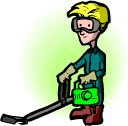Weed Wackers (Download)
Weed Wackers Description A weed wacker works on the principle that a line that is turned fast enough is held out from its housing (the rotating reel) very stiffly by centrifugal force. The faster it turns the stiffer the line. Even round-section nylon line is able to cut grass and slight, woody plants quite well. These lines make disks less necessary for tough jobs. History The string trimmer was introduced in the early 1970’s by George Ballas of Houston, Texas. He got the idea while taking his car through an automatic wash and watching the revolving action of the cleaning brushes. He attached pieces of heavy-duty fishing line to an empty popcorn can bolted to an edger. From this he went on to develop his string trimmer called “Weed Eater” because of the way it chewed up grass and weeds around trees. Weed Wacker Uses Weed wackers are primarily used in the landscaping aspect of construction. Used to cut through weeds and overgrown areas. Used to trim grass/weeds around trees. Most have attachments for edging curbs and sidewalks. Safety Hazards Eye injuries Lacerations Weed wackers can send debris flying back at the operator and others in the area of operation. The rotating line can lacerate ankles, feet and legs if not protected. Heat related illnesses Back strain Wrist strain Eye injuries Eye injuries are common for both users and bystanders Weed wackers can throw projectiles in the form of objects such as sticks, stones, and other objects. Lacerations Lacerations to legs are very common. The string from the weed wacker can cause a cut to the leg if not carefully used. Heat Related Illness From 1999-2003, a total of 3,442 deaths were reported in America from exposure to extreme heat. Heat related illness include: Heat rash, heat cramps, heat edema, heat tetany, fainting, heat exhaustion, and heat stroke. Heat exhaustion and heat stroke need IMMEDIATE medical attention. Source: http://www.cdc.gov/mmwr/preview/mmwrhtml/mm5529a2.htm Source: http://firstaid.webmd.com/tc/heat-related-illnesses-topic-overview?page=2 Others Back strain Excessive use of weedwackers can cause back strain due to the weight of the equipment Wrist strain Weedwacker strains the wrist if used for a long duration Fatality Statistics There are no weed wacker-related fatalities that were investigated by OSHA Accident from 1990 thru 2009. The U.S. Consumer Product Safety Commission estimates that in 1989 there were approximately 4,600 hospital emergency room-treated injuries (not specific to construction) associated with power lawn trimmers or edger’s. About 1/3 were eye injuries. Source: http://www.mydiscounttools.com/estore/safety/weedtrimmersafety.html Source: Extracted from OSHA Accident Investigation Data 1990-2009 OSHA Regulations The OSHA Regulations do not specifically mention weed wackers. Eye Protection Use safety glasses and/or goggles to protect the eyes from dust, dirt, trash, and small rocks thrown by the rotating line. Face screens in combination with safety glasses and/or goggles provide better protection. Safety Procedures Suggested PPE Clothing protects the operator from thrown objects and sun exposure. Dress properly for the job, wearing long pants, and close-fitting clothes. Chaps to protect the legs may be required. Tie back long hair and do not wear anything that could become entangled in the moving parts of the trimmer. Boots Always wear sturdy, non-slip soled shoes or boots when using a weed wacker. Hearing Protection Use earplugs or muffs for hearing protection from engine and blade noises. Hand Protection Select equipment with anti-vibration components or wear gloves for protection. Good Bad The man above is wearing proper protective equipment such as: long pants, glasses, and gloves. The man above is not wearing protective equipment such as: glasses, long pants, or gloves. Protection from the SUN Wear appropriate sunscreen to protect from the sun’s rays. Take frequent breaks on hot work days to avoid dehydration. Fueling Safety Use proper fuel (two cycle gas/oil mixture) if weed wacker is gas powered. Do not overfill the tank, leave room for expansion. Do not add any fuel if the engine is still hot; let it cool down before re-fueling. Never light a match or smoke around gasoline. Operational Safety • Read the operator’s manual to find out where controls are located and how they function, as every weed wacker is different. Check for additional safety instructions in the operator’s manual and know how to stop the machine quickly. • Before weed wacking, walk the area and pick up objects lying on the lawn. Tools, cans, bottles, wire, rocks, sticks, twigs, and limbs can be hazardous to bystanders and the operator. Operational Safety • Never allow untrained individuals to operate weed wackers. Operational Safety Ensure that there is an adequate supply of string Check the fuel level. Make sure the muffler is in good condition. In dry weather, use a fire-safe muffler. • Keep shields and other guards in place and working properly. When working long periods of time, use shoulder straps to help support the weed wacker Survey the Area Look for miscellaneous objects that might by hidden by the grass. Review the possibility of contacts with ticks, poison ivy, snakes, etc. Keep People at Safe Distances WARNING – Weed wackers and string trimmers can throw objects violently, up to 30 feet. Keep people AT LEAST 30 feet (60 foot diameter) away to avoid possible injury. Stop immediately if approached. Operation of Weed Wackers Start the unit on firm ground or other solid surface in an open area. Hold the unit with both hands. Keep a firm footing. Keep the trimmer head below waist level. Always stand on the proper side of the trimmer while cutting. On a curved shaft unit, the line head rotation is clockwise (cut on the left side.) On a straight shaft unit, the line head rotation is counterclockwise (cut on the right side). Operation of Weed Wackers Bring the engine to operating speed before starting to cut vegetation. Do not operate engine faster than needed to effectively cut the vegetation. Allow the engine to return to idle speed when not cutting. Always turn off the engine and disconnect the spark plug wire, if accessible, before attempting to unclog or adjust the weed wacker. To avoid placing hands near the rotating line, use a stick to remove the clog. Keep Trimmer in Peak Operating Condition Inspect the weed wacker periodically for potential hazards such as loose belts, and missing or damaged guards. Also examine the weed wacker for accumulations of grass, leaves, or excessive grease to reduce fire hazard. Conduct routine maintenance and inspections. Perform a safety check before and after each use of the trimmer Check and tighten all loose nuts, bolts, and screws Clean trimmer after each use Shut Down of Weed Wacker Idle down the engine a few minutes to allow the engine to cool down. Stop the engine before putting the weed wacker down. Always clean the weed wacker after use. Do not spray cold water on a hot engine. Secure the trimmer to prevent fuel spillage and damage during transport. Keep the cutter tool covered with the carrying guard. Key Points to Remember Do not edge with trimmer Keep string horizontal http://www.youtube.com/watch?v=K8fdplx0LzA SAFETY VIDEO Think Safely Work Safely

